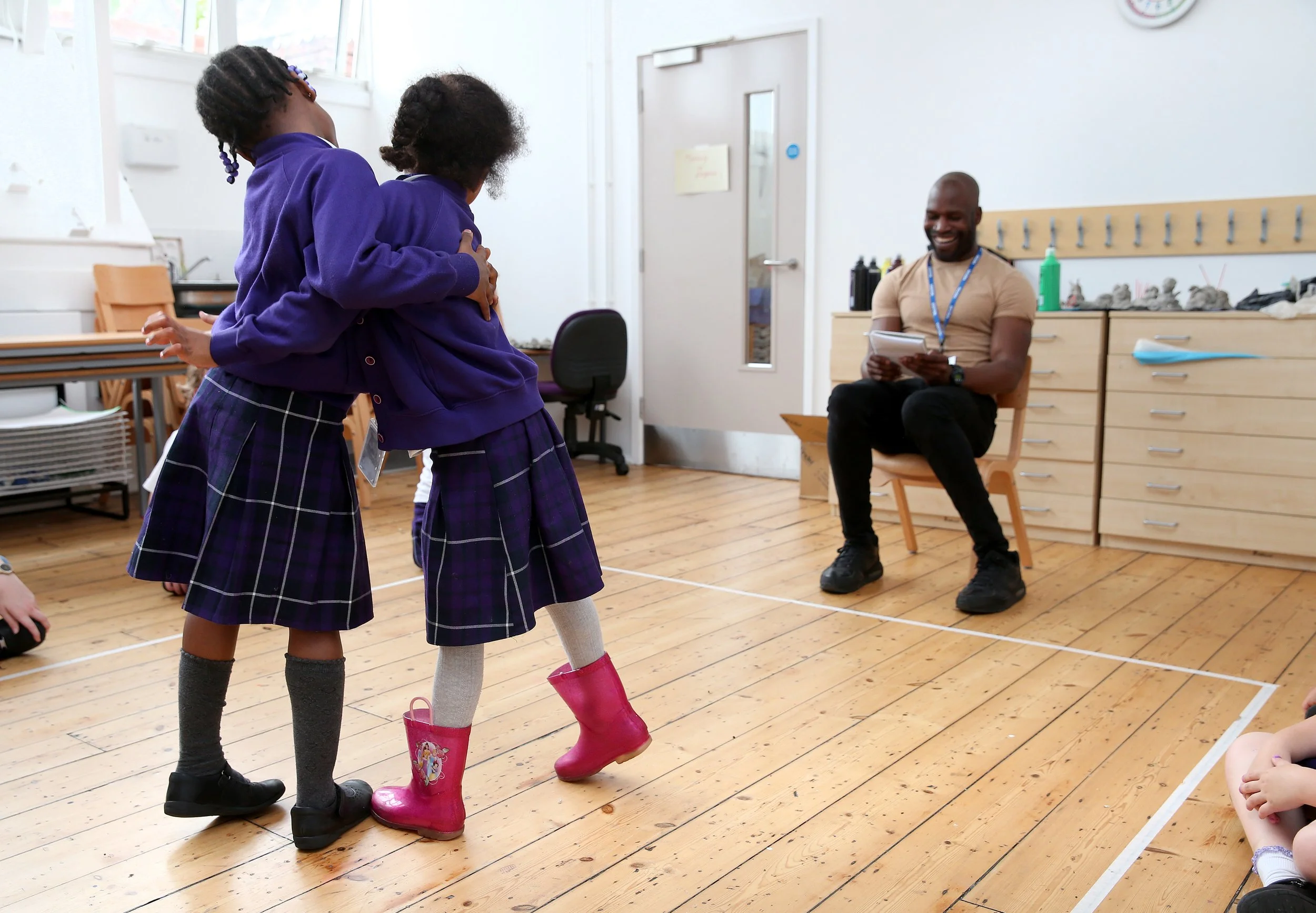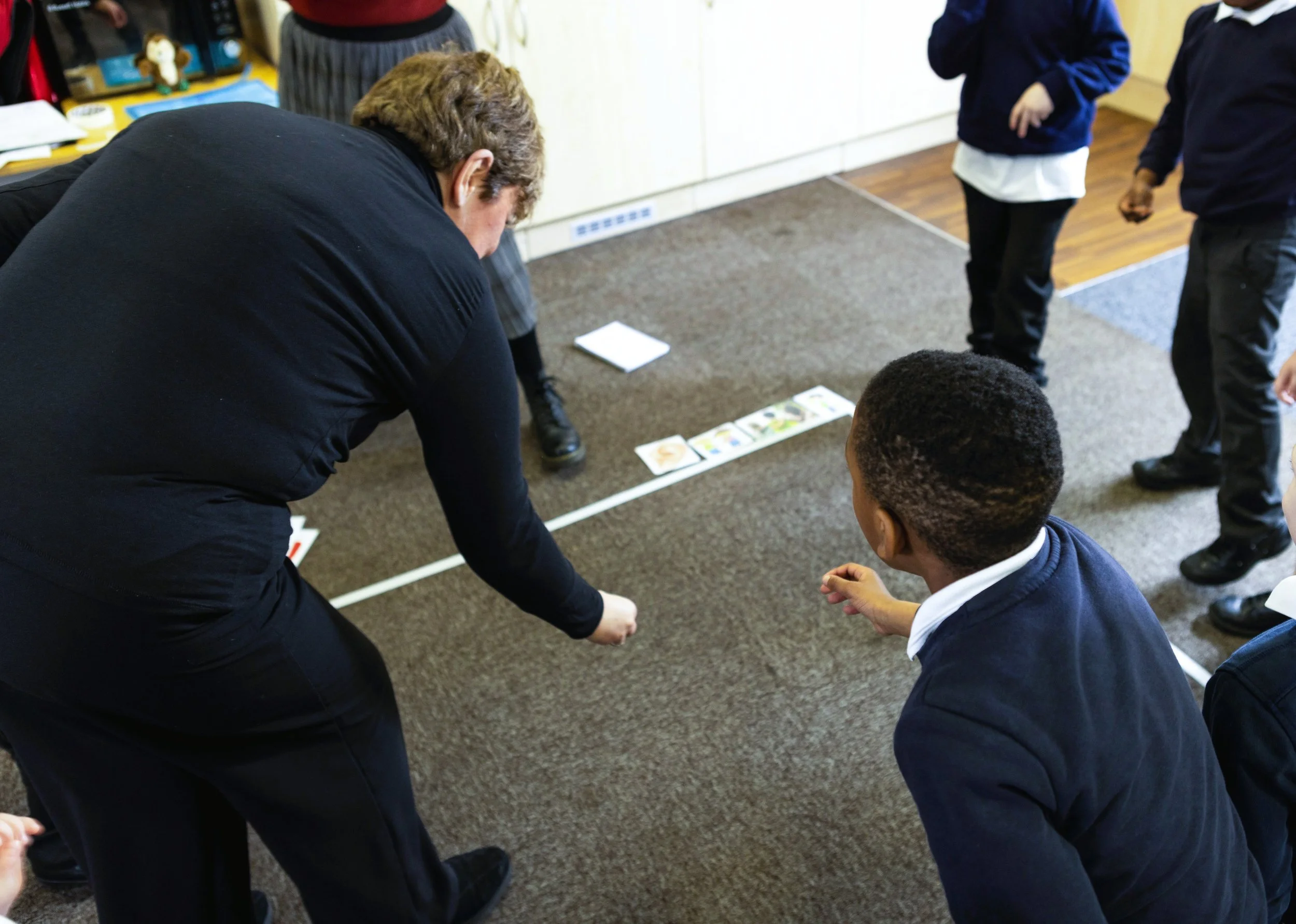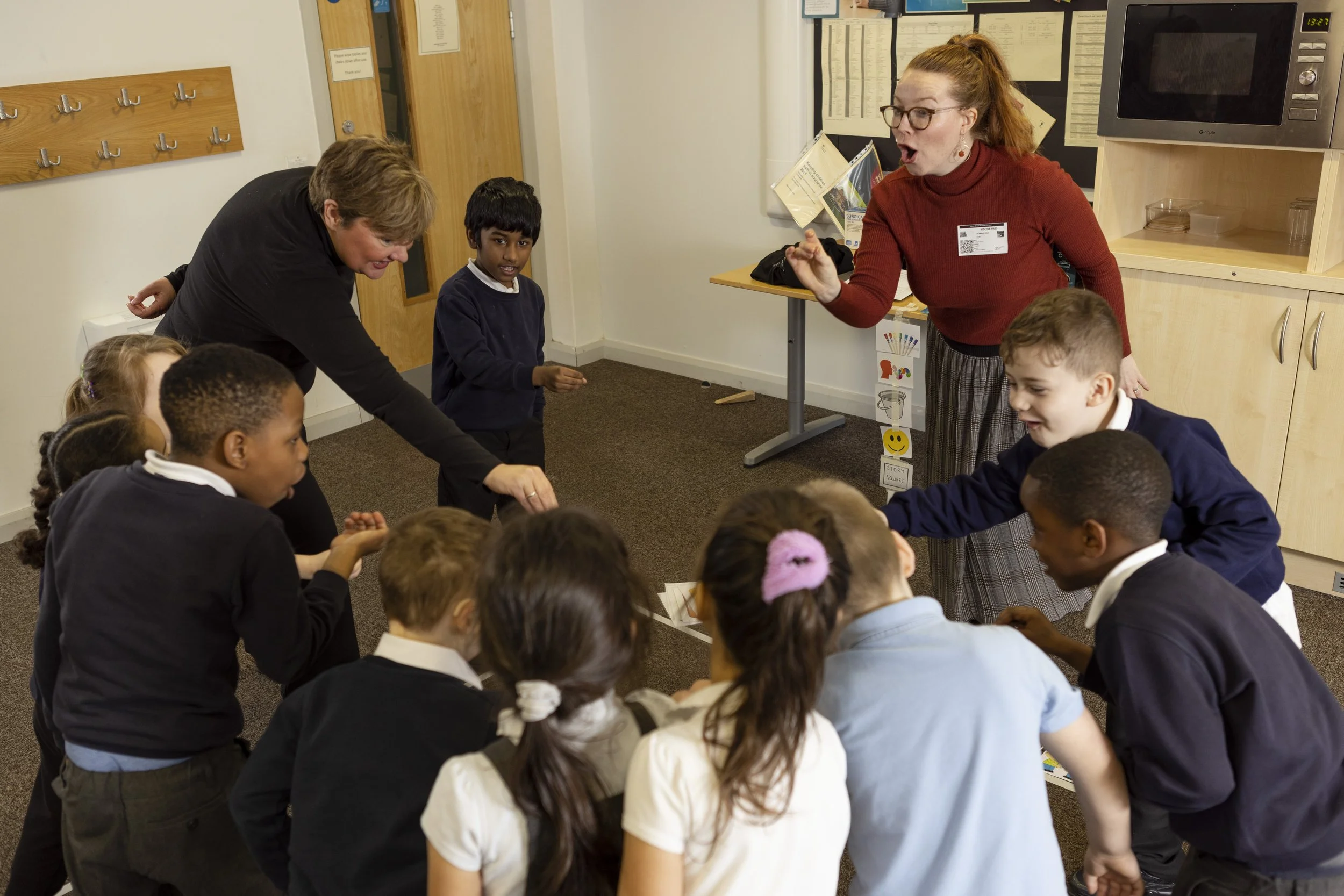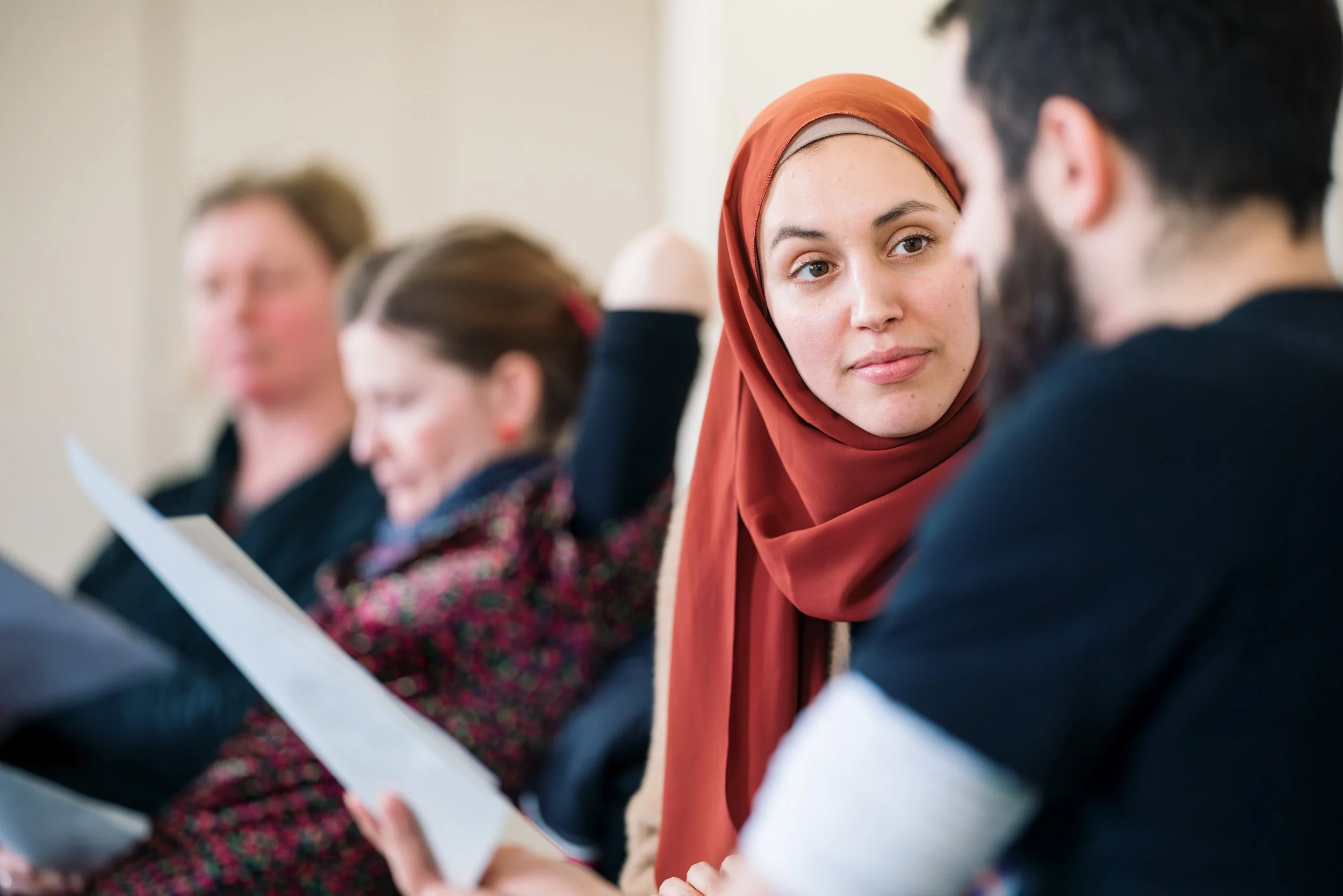The Story Square by Sarah Kadri
Introduction: Sheer joy
“Yes! It’s the story square! This is my most favouritest bit!”
In Speech Bubbles, referred children of primary school age with speech and communication challenges, take part in a weekly group drama session delivered by a drama practitioner. The aim is to build the children’s confidence, communication and creativity. An interesting tension exists during Speech Bubbles sessions. For the first half, the facilitator is in control, a set routine is followed where children learn the norms of how act in the space. Then something magical happens. The second half ushers in the ‘story square’. At this point, the children, each and every time, display wide smiles, high-pitched giggles, and wriggles of anticipation – sheer joy. What is it about the story square that instantly transforms the atmosphere and makes it something that ‘children would give up play time’ for (Armstrong, 2006, p.34)?
In this brief essay, I explore the importance of free crafting and communal playback to the children’s experience of building communication skills. Dewey states that, regarding learning, ‘everything depends on the quality of experience’ and in an educational setting usually associated with ‘ennui and boredom’ (1997, p. 27), the story square provides a radical shift, where children take ownership of their story - this is the quality mark of experience.
The power of the wish in children’s stories is ever present, and so it too becomes alive outside the story - the children’s wishes are granted, they are the tellers and the players. Children who cannot read or write independently, and whose narratives are laden with charming self-contradictions, are considered as worthy storytellers.
Free Crafting
Scaffolding plays a major part of the Speech Bubbles method. Andrew Wright, teacher trainer and storyteller, comments, ‘it is difficult for anyone to invent a story suddenly without being in a story-making frame of mind’ (2013, p.12). Speech Bubbles sessions begin with multiple exercises (e.g., ‘name in the bucket’, where children create an imaginary bucket with vivid description in which they throw their names, in character) that promote narrative building, in preparation for the story square. Children are initiated into an important task at the end of each session: to craft their very own story. I use the term ‘free crafting’ to refer to the children’s creative practice as they form their unique story in a self-directed setting. During this process, the facilitator has one role, to scribe the child’s words. The child is invited into an expansive space of possibilities, where everything that comes to them is given significance on the page.
“The commonest mistake made about freedom is to identify it with freedom of movement, or with the external or physical side of activity. Now, this external and physical side of activity cannot be separated from the internal side of activity; from freedom of thought.’ ”
In Speech Bubbles, children are encouraged to use their bodies and ideas creatively and boldly to express themselves. What the story square brings in particular is the fundamental right to freedom of thought - contrary to the schooling system which rewards conformity and blind submission to authority and prescribed curricula - as the child is never told what to think, never prompted to a better thought. There is simply no right or wrong.
This marks an important development in children finding out what matters to them, what their unique story is about, as Wright says: ‘when we make stories, we take our experience and make it meaningful for ourselves rather than waiting for other people to do it for us (2013, p.3). As the facilitator follows the lead of the child, they too are benefiting from this authentic approach, for what could tell us more about a child than observing the choices they make when possibilities are endless? McTamaney echoes, ‘We find ourselves with a more sincere understanding of the child both because we take the time to know him and because we have done so with his tools’ (2007, p.159).
When the child is crafting their story, not only are their ideas valued but also how they express them. The facilitator is an enthusiastic yet largely silent scribe. The child is not asked to think consciously about the accuracy of their narrative or grammar. The facilitator rejoices in the child’s willingness to contribute, this is their gift to the child. An illustrative account told by Andrew Wright is relevant to bring up here:
“When my son was eleven and just starting secondary school in England, he wrote a story entitled ‘The End of the World’ in five lines. The teacher had written underneath, ‘Five spelling mistakes. Correct them.’ I said, ‘Tom, you have managed to bring about the end of the world in five lines! Congratulations’. He replied, ‘There’s something you learn at school. The less you do, the less mistakes you can make.’ What a tragic position for a child to take. ”
What the story square does, in direct opposition to this, is engage with mistakes by positing creativity as the core element of the exercise. The aim is for the child to trust that they have a story to tell and then to have the confidence to tell it - and this, for children with speech and communication challenges can be particularly daunting. Patrick highlights that ‘sustaining creativity engages one in risk-taking and experimentation, which promotes greater confidence’ (2020, p.137). In other words, it is the creative process that carries the child through what could be unknown. Recording the child’s words verbatim, without correction or prompting, tells the child that correctness and certainty of outcome is not what is required but rather an open-ended exploration.
Even though no attention is granted to accuracy, this does not mean that the child’s story is senseless or without literary qualities. In fact, stories are often complex and display implied canonicity. The narrative frame is poised between ‘once upon a time’ and ‘happy ever after’, whilst stretched and altered to encompass the surprises and twists that live in the child’s mind.
Take this as an example (from which an extensive commentary could be written): ‘the girl hearded him through the window but he didn’t see her, so then she jumped up the highest, like a giraffe in the clouds, then he said: stop so you don’t make the thunder come down!’ (Anonymous, 2023).Armstrong describes young children as ‘people who dare to reinvent mythology’ (2006, p.31).
Indeed, there is an important purpose for children to adapt and reinvent the literary forms that they inherit. As well as creating fantastical material, the child not only incorporates their own experiences in the storytelling but processes them. Siegel writes, ‘when children learn to pay attention to their own stories, they can respond in healthy ways to everything from a scraped elbow to a major loss or trauma (2012, pp.28-29)’. The significance of storytelling, straight from the child’s mind-eye, is that they learn more about themselves, the natural world, ‘and the various kinds of actual and potential human worlds’ (Richardson, 2010, p.33).
Communal Playback
The free crafting of the child’s story is an intimate affair, where the facilitator is almost effaced, vacating space for the child to be with their own thoughts. Some children jump around to process their ideas, whilst others sit still and concentrate on one spot as they piece their narrative together. In all cases, the children rarely interact with the facilitator, and rarely look for approval or guidance. They are creating for themselves. The story resides in their mind and now on paper, just for them. This all changes the following week, when their story is presented to the group, who is called to act it out in the story square. The switch of the container of the story from internal narrative to group script is stark – and the children are no less enthusiastic to initiate it. Their wish is now to communicate their story to others.
The collective dramatization of the child’s story calls every member into a type of organic play, where children improvise with each other on what the characters do and how they respond – this skill is the natural prerogative of childhood.
The example of the evil penguins who are given a secret by the good panda, to then become helpful penguins, comes to mind here. Interestingly, the story square takes the story back to its origins, i.e., the child’s mind processing their own experiences of play, and reinstates it into the story square with the crucial layer that the play is now guided by the child’s own recorded text - a script truly fit for its actors.
The story, that is read aloud verbatim by the facilitator, goes through a process of transferal of ownership. This process is mirrored in the practice of playback theatre, otherwise commonly used in social justice and trauma settings. The improvised nature of playback theatre engenders the negotiation of new meanings as actors play out the witness’s story, which ‘immediately disturbs the possibility of one interpretation’ (Dennis, 2008, p.214). In Speech Bubbles, as soon as each member stands in the square to act out the story, they effectively participate in the act of storytelling themselves as they offer extensions and unique interpretations of the spoken text. The distinction between the author and actor/audience becomes blurred. The original storyteller is often excited by the new proposals, as if it was exactly what the story was made for, a genuine community practice – this marks the ‘communal life of children’s stories’ (Armstrong, 2006, p.30). Even the child sitting on the time-out chair will growl, their limbs dancing in character, eager to participate. Dewey remarks that children ‘are willing […] to take suggestions from one child and let him be a leader if this conduct adds to the experienced value of what they are doing, while they resent the attempt at dictation’ (1997, p.55). The last clause is important to note, as it highlights that what makes story square a sheer delight for the children is the unwritten rule that no one person dictates - that would be no fun. There is no single version of the story, and therefore no correct version. It only works when a process of co-creation is respected.
Paley states that to leave the story untold and unacted, makes ‘the process incomplete’ (Armstrong, 2006, p.30). Particularly for storytelling, the enjoyment lies in the varying sounds, voices, and moving bodies that help to make the story what it is. Siegel suggests that ‘we are always in a perpetual state of being created and creating ourselves’ (2020, p.221). It is through the various layers of creative processes that the children deepen and build on their sense of self.
Additionally, through trying out different hats and observing multiple interpretations unfold, the children learn perspective and turn taking in an organic and playful way.
Reflection: Soft wax
McTamaney writes that ‘the training of the teacher is something far more than learning ideas. It includes the training of character’ (2007, p.66). The first time I recorded a child’s story in preparation for the SS, I found an agonising tension within me - how challenging it was for me to hold back my ideas each time a child would pause pensively; how frustrating it was to bite my tongue at the encounter of every grammatical mistake. The shift happened when I read the story back to the child to ask for a title and any final edits. My gaze (previously glued to the page - how fast can you scribe a narrative tumbling down that knows no punctuation?) met their sparkling eyes, filled to the brim with pride – ‘nothing, that’s it, I don’t want to change anything’ they said before speeding out of the room as a hungry velociraptor (anonymous, 2023).
At that point I squarely knew that this exercise was not about me or my thoughts, nor the accuracy of language. The story square is all about the child, and it is only through ‘unbiased observation that our compassion emerges for each child we serve’ (McTamaney, 2007, p.46).
Seeing this child’s story acted out in the story square for the first time, I was convinced that they considered themselves as a skilled author and so did the other children, who fully accepted their narrative and made it even bigger and brighter (I mean, how many times can a tiger-horse come back to life with fairy dust?).
After that initiating event, my pen would effortlessly flow on the page as I scribed. I understood the significance of the story square, which offers a sincere recognition of the artistic genius of children and knows the fragility of a budding self-worth and creative ownership. McTamaney captures this imperative beautifully: ‘Do not erase the designs the child makes in the soft wax of his inner life’ (2007, p.18).
Conclusion
The success of the story square has concrete implications for how we engage with children and education, which is commonly seen as the ‘initiation of children into culture’ (Armstrong, 2006, p.174). What the story square shows is that children are in fact not passive recipients but that they actively form meaning through the telling and retelling of narrative – a creative and critical practice present in their earliest years. Contrary to the current system which posits that children must be taught how to express themselves accurately in order to contribute to the culture of their community, the story square provides evidence that children use what is already in them – creatively, through crafting a story to playing it back – in order to learn how to better contribute. The process is child centred. Montessori said, ‘one test of the correctness of educational procedure is the happiness of the child’ (1989, p.24); the story square provides a strong case of this.
Bibliography
Anonymous (2023) Conversation with Sarah Kadri, 2 June. Armstrong, M. (2006) Children writing stories. Berkshire: Open University Press Dennis, R. (2008) ‘Refugee performance: aesthetic representation and accountability in playback theatre’, Research in Drama Education, 13(2), pp. 211-215. Dewey, J. (1997) Experience and education. New York: Touchstone McTamaney, C. (2007) The Tao of Montessori: reflections on compassionate teacher. USA: iUniverse Inc Montessori, M. (1989) What You Should Know about Your Child. Oxford: ABC Clio Ltd. Patrick, S. (2020) ‘Mistakes as pathways towards creativity in counseling: a case example’, Journal of Creativity in Mental Health, 15(1), pp.128-138. Richardson, L. (2010) ‘Getting personal: writing stories’, International Journal of Qualitative Studies in Education, 14(1), pp.33-38. Siegel, D. (2020) The developing mind. New York: The Guilford Press Siegel, D. (2012) The whole-brain child. London: Constable & Robinson Wright, A. (2013) Creating stories with children. Oxford: Oxford University Press.






